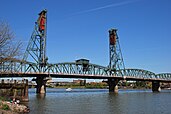The main change is putting everything in hide/show boxes, with the result that on the initial load all the sections can be seen without scrolling down ( Does it work? Discussion started here).
Still to do:
- Fix TFP and Sisters - for some reason, the template I wrote doesn't like hiding tables. I've left the old TFP up for comparison. I can't for the life of me figure out what's wrong. Can anyone figure it out the problem in my code?
- Write a version of User:Eitch/Main Page/Framed hidden that supports multiple columns (so far, it supports a single column with multiple boxes, each of which has the same coloring).
- Can someone figure out how to make the heights of the blue and the green tables independent of each other?
- The width of Sisters is less than that of the sections above it (you can't appreciate this, since Sisters isn't hiding. The width of Languages is even less. Can someone figure out why?!?
Done:
- Broke things up into templates:
- Framed hidden easily makes things that look like TFP, Sisters, or Languages - hide/show boxes with a frame.
- Hidden2 easily makes things that look like TFA, DYK, ITN, or OTD.
- Welcome banner makes a welcome banner - customize the stuff to the right of and below "welcome to wp"
Hide/Show trouble: why is there too little space between the "Today Featured Article" headline and the FA; too little space between the "Today's Featured Picture" headline and the FP; there's too much space between the "Did you know…" headline and DYK.(disussion started here
The sister projects and other languages boxes should have the same color scheme - they're different to show two possibilities (discussion started here).
- I moved the "other areas" links to the top banner - nubies are the ones who won't know about the links already, and so they should be prominent.
I need someone with better table skills to figure out why there's an a little white square below the Today's Featured Article and Today's Featured Picture introductions (the whole line the square's on shouldn't be there; discussion started here).
Can someone figure out why the "Recently featured" links aren't hiding along with Today's FA?(fixed!)
The search box was written by Trevor MacInnis.
Many thanks especially to ChyranandChloe for programming help.
|
Browse the Featured content, Portals, Categories, or the A–Z index. | |
|
New to read or editing Wikipedia? Read the Overview, the Editing Tutorial, the Common Questions, or the Help pages. Check the Site news for news about Wikipedia, and the Community portal to learn about projects you can get involved in. Still have questions? Head to the Help desk, the Reference desk, or the Village pump. | ||
|
|
|
|
Images on Wikipedia which the editing community finds "beautiful, stunning, impressive, and/or informative" are declared Featured Pictures. Today's featured picture {| role="presentation" style="margin:0 3px 3px; width:100%; box-sizing:border-box; text-align:left; border-collapse:collapse; "
|
|}
|
Wikipedia is hosted by the Wikimedia Foundation, a non-profit organization that also hosts a range of other projects Wikipedia's sister projects {|width="100%" align="center" cellpadding="4" style="text-align:left; background-color: transparent;"
|
|}
|
This Wikipedia is written in English. Many other Wikipedias are available; some of the largest are listed below. Wikipedias in other languages
|













